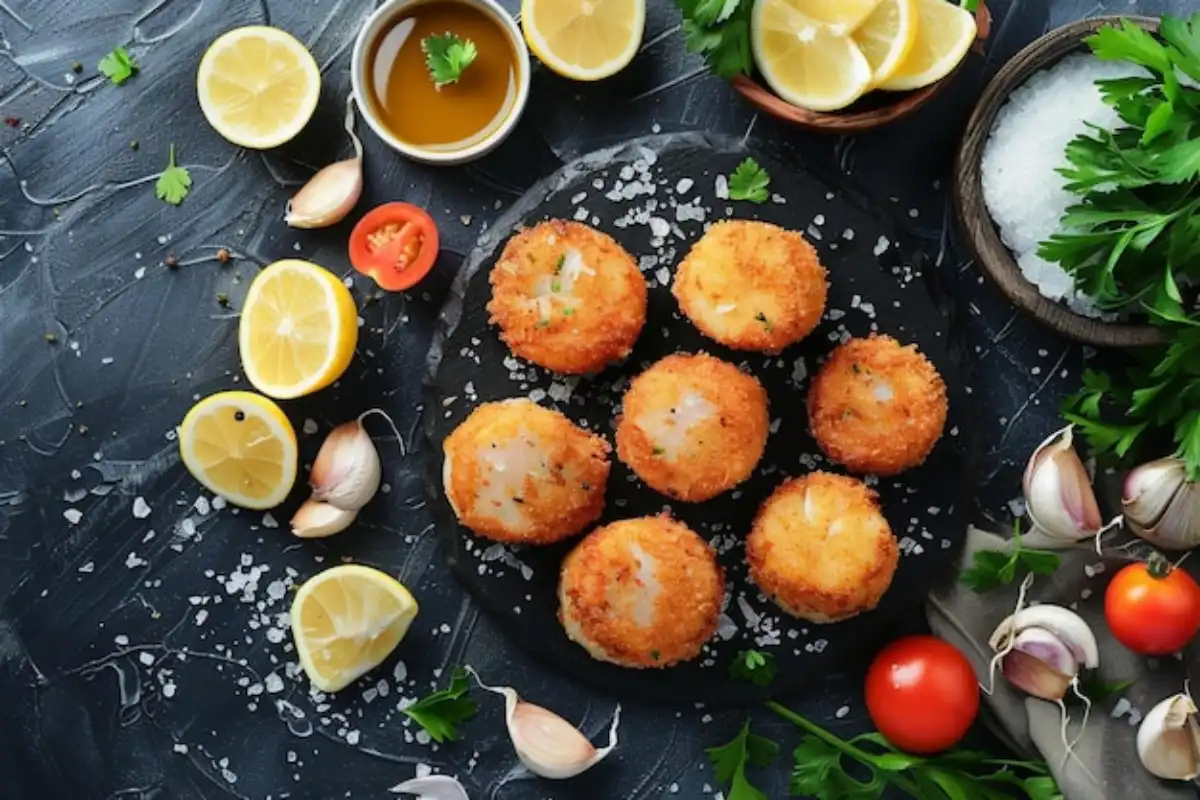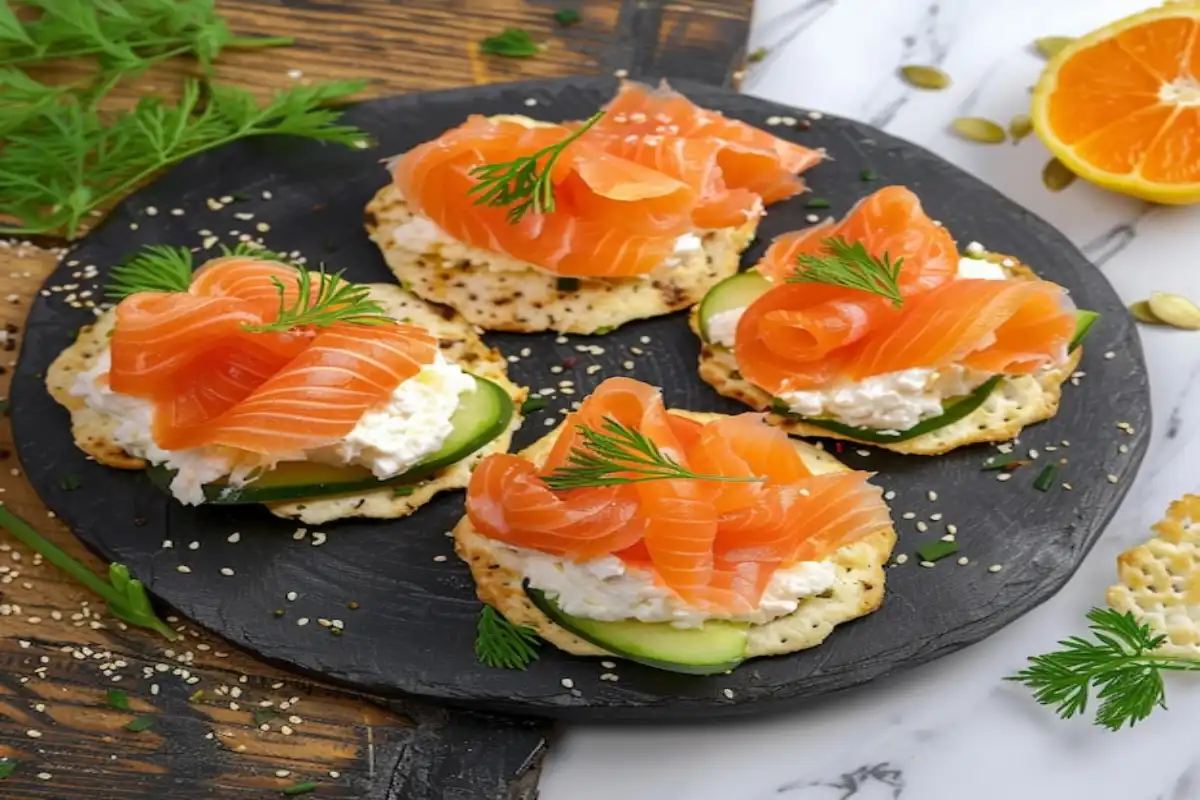One of the most versatile and tasty appetizers is salmon bites. Whether you’re a seasoned chef or a home cook looking for something healthy and simple to make, salmon bites fit the bill perfectly. Not only are they packed with nutrients like Omega-3 fatty acids and high-quality protein, but they are also adaptable to various cooking methods, dietary needs, and flavor profiles.
This article will thoroughly examine the components of salmon bites, the diverse ingredients utilized in their preparation, and the ways to explore diverse flavors and variations. By the end of this guide, you’ll have all the information you need to create the perfect salmon bites, regardless of your culinary skill level. Let’s dive in!
1: Introduction
Small, bite-sized portions of salmon, usually seasoned and cooked by frying, baking, or grilling, are known as salmon bites. Depending on how you serve them, these bites make excellent appetizers, snacks, or even main meals.
Why are salmon bites popular?
- Healthy: Salmon is a well-known superfood, rich in Omega-3 fatty acids that benefit heart and brain health. It’s also an excellent source of protein, making it ideal for those following high-protein diets like keto, paleo, or low-carb.
- Easy to Make: Salmon bites are simple to prepare and cook, requiring just a few basic ingredients. Whether you’re preparing them for a party or a weeknight dinner, they are quick and convenient.
- Versatile: You can modify the recipe to fit a variety of diets and taste preferences, ranging from spicy to creamy and everything in between.
Salmon bites are a fantastic option whether you’re planning a healthy snack, hosting a party, or simply looking for a protein-packed appetizer. They’re simple to prepare, adaptable to any diet, and abundant in essential nutrients like Omega-3 fatty acids and protein.
Main Ingredients of Salmon Bites
1. Salmon: Fresh vs. Canned
Of course, the salmon is the star of the show. However, not all salmon possesses the same qualities.
- Fresh Salmon: Fresh, wild-caught salmon. It has a cleaner flavor and is often more nutrient-rich compared to farmed salmon. You can use wild-caught salmon fillets for the best results. If you want a smoother texture, finely chop the fresh salmon or pulse it in a food processor.
- Canned Salmon: If you’re short on time or budget, canned salmon is a wonderful alternative. It’s already cooked and simple to work with, though the flavor might not be as fresh as a fillet. Make sure to use boneless and skinless canned salmon for the best texture. If necessary, drain the salmon well before using it in your recipe.
2. Binding Ingredients
One of the most important aspects of making salmon bites is ensuring that they hold together properly. This is where binding agents come in.
- Eggs: Eggs are a crucial binding agent in salmon bites. They help hold the mixture together while it is cooking.
- Breadcrumbs: Panko or traditional breadcrumbs are common options. If you’re looking for a gluten-free or low-carb alternative, you can use almond flour, coconut flour, or crushed gluten-free crackers.
- Dairy-Free Alternatives: If you have dietary restrictions, you can experiment with flax eggs (ground flaxseed mixed with water) as a vegan alternative.
3. Seasonings and Herbs
Seasonings and herbs bring flavor and depth to the salmon bites, enhancing the natural flavor of the fish without overpowering it.
- Dill: This herb pairs wonderfully with salmon and gives the bites a fresh, bright flavor.
- Lemon Zest: Adds a citrusy brightness that balances the richness of the salmon.
- Garlic and Onion Powder: These seasonings provide a deeper flavor profile without taking away from the salmon’s natural taste.
- Parsley and Cilantro: Fresh herbs add vibrancy and color, complementing the savory taste of the bites.
4. Flavor Enhancers (Optional)
You can customize your salmon bites with additional flavorings, depending on your preferences.
- Cream Cheese or Feta: Adding a small amount of cream cheese or feta gives the salmon bites a creamy, rich texture. This works particularly well if you want a more indulgent flavor.
- Spices: To add heat, include chili flakes, Sriracha, or cayenne pepper in your salmon mixture.
- Soy Sauce or Dijon Mustard: For a more umami-rich profile, you can add soy sauce or Dijon mustard.

3: How to Make Salmon Bites—Step by Step
Now that we know the main ingredients for salmon bites, let’s move on to the process of making them.
1: preparing the salmon
Start by prepping the salmon. If you’re using fresh salmon, you’ll need to remove the skin and bones, then chop it finely. For canned salmon, simply drain and flake it with a fork.
2: Combining Ingredients
In a large mixing bowl, combine your salmon, eggs, breadcrumbs (or your choice of binder), seasonings, and any optional flavor enhancers. Be sure to mix the ingredients thoroughly but gently, so as not to mash the salmon too much.
3: Shaping the Bites
Using your hands or a spoon, shape the mixture into bite-sized balls or patties. Each bite should be about 1-2 inches in diameter. Ensure that the mixture is compact to prevent the bites from falling apart during cooking.
4: Cooking the Salmon Bites
Pan-Frying Method:
- Heat olive oil or butter in a non-stick pan over medium heat.
- On each side, fry the bites for 3-4 minutes until golden brown and cooked through. Be careful not to overcrowd the pan to ensure even cooking.
Baking Method:
- Preheat the oven to 375°F (190°C).
- Arrange the bits on a baking sheet lined with parchment paper.
- Bake for 12-15 minutes, flipping halfway through, until golden and firm.
Air Frying Method:
- Preheat your air fryer to 400°F (200°C).
- Arrange the bites in the air fryer basket, ensuring they don’t touch each other.
- Cook for 8-10 minutes, shaking the basket halfway through.
5: Providing suggestions
Salmon bites are best served warm, with a variety of dipping sauces like tartar sauce, lemon aioli, or a spicy Sriracha mayo. Garnish with fresh herbs or a squeeze of lemon for added freshness.
4: Variations of Salmon Bites
Salmon bites are beautiful because of their versatility. Here are some popular variations you can try:
1. Classic Salmon Bites
For a simple, no-fuss version, stick to the essential ingredients of fresh salmon, breadcrumbs, eggs, and basic seasonings like dill and lemon.
2. Spicy Salmon Bites
If you’re a fan of heat, you can add chili flakes, cayenne pepper, or even Sriracha to your salmon mixture. This variation pairs beautifully with a cooling yogurt-based dip.
3. Creamy Salmon Bites
Incorporate cream cheese or feta into the mixture for a richer, creamier texture. This variation works well for those who want a more indulgent flavor.
4. Keto and Low-Carb Salmon Bites
For those following a keto or low-carb diet, replace breadcrumbs with almond flour or crushed pork rinds. These alternatives still provide a firm texture without the carbs.
5. Asian-Inspired Salmon Bites
To give your salmon bites an Asian twist, incorporate soy sauce, sesame oil, and ginger into the mixture. For an umami-rich snack, serve with a side of soy sauce or teriyaki dipping sauce.
5: The Nutritional Benefits of Salmon Bites
Salmon is one of the healthiest proteins you can consume, and salmon bites retain all those nutritional benefits in bite-sized form.
1. Fatty Acids (Omega-3)
Salmon is known for being an excellent source of Omega-3 fatty acids. These healthy fats support heart health, reduce inflammation, and improve cognitive function.
2. High in Protein
These bites of salmon, a protein powerhouse rich in lean, high-quality protein, serve as a satisfying snack or meal that promotes muscle growth and weight loss.
3. Rich in vitamins and minerals.
Along with minerals like selenium and potassium, salmon is also rich in essential vitamins like B12 and D, which support everything from immune function to bone health.
Nutritional Breakdown (Per 3-4 Salmon Bites):
- Calories: 150-200
- Protein: 18-22 grams
- Fat: 8-10 grams (depending on cooking method)
- Carbohydrates: 5-10 grams (with breadcrumbs)
6: Frequently Asked Questions (FAQs) About Salmon Bites
1. For salmon bites, what is the best type of salmon to use?
Fresh, wild-caught salmon is the best type for making salmon bites. However, canned salmon can be a wonderful budget-friendly alternative, particularly if it’s boneless and skinless.
2. Can you prepare salmon bites in advance?
Yes, you can prepare the salmon mixture ahead of time and store it in the fridge for up to 24 hours before shaping and cooking the bites. You can also freeze the cooked salmon bites and reheat them when needed.
3. How do I keep my salmon bites from falling apart?
The key to keeping salmon bites intact is using enough binding agents (eggs and breadcrumbs) and ensuring the mixture is compact when shaping the bites. Avoid overmixing the ingredients, as this can make the bites crumbly.
4. Are there gluten-free options for salmon bites?
Yes! Simply replace the breadcrumbs with a gluten-free option like almond flour, coconut flour, or crushed gluten-free crackers.
5. What dipping sauces go well with salmon bites?
Popular sauces for salmon bites include tartar sauce, lemon aioli, dill yogurt dip, and spicy Sriracha mayo. You can also try serving them with a soy-based sauce for an Asian-inspired twist.
7: Pairing Ideas: What to Serve with Salmon Bites
You can pair salmon bites with a variety of sides and beverages to create a well-rounded meal.
Side Dishes:
- We serve fresh green salads with a lemon vinaigrette.
- I enjoy roasting vegetables such as asparagus or Brussels sprouts.
- This is a light quinoa salad with herbs and lemon dressing.
Beverage Pairings:
- Choose a crisp white wine such as Sauvignon Blanc or Chardonnay.
- For a non-alcoholic option, try sparkling water with a splash of lemon.
8: Tips for Making the Perfect Salmon Bites
Here are a few tips to ensure your salmon bites turn out perfectly every time:
Cooking Tips:
- Avoid overcooking your salmon bites to ensure they remain moist and tender.
- Use a meat thermometer to ensure the internal temperature reaches at least 145°F (63°C).
Storage Tips:
- Store leftover salmon bites in an airtight container in the refrigerator for up to 3 days.
- To freeze, lay the cooked bites on a baking sheet and freeze until solid, then transfer them to a freezer-safe bag or container.
Conclusion: Why Salmon Bites Should Be Your Next Favorite Appetizer
Salmon bites are not only a delicious and healthy option for any meal but also incredibly versatile. Whether you want to keep it simple with a classic recipe or spice things up with a bold variation, these bites are sure to please. Packed with essential nutrients, they’re an excellent choice for those looking to incorporate more Omega-3 fatty acids and protein into their diet.
For more easy-to-make appetizers, check out this delicious No-Bake Cheesecake Filling. Pair your salmon bites with a warm bowl of soup, like this Ultimate Guide to Slow Cooker Soup. Looking for more savory dishes? Try this Garlic Parmesan Chicken Pasta Recipe.
Don’t hesitate to experiment with these delicious salmon bites for your next meal or gathering. Serve them with your favorite dip, pair them with a crisp beverage, and enjoy the unbeatable combination of taste, nutrition, and simplicity.

